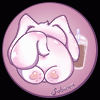
As i'm tied-up getting some commissions done i thought i would post some stuff from my dA gallery this week - some fractals, fantasy art, op-art, fine-art, illustrations etc....i'll move all non-anthro art to my scaps in a few days after posting....sorry for delay on new anthro pics...soon....
This works fairly well in any rotation - i seem to have favored the descending one as there is a sense of momentary rest....
Apophysis from a few years ago...
Frame PaintshopPro 7
Large size version at dA:
http://lachland-nightingale.deviant.....llet-339614964
This works fairly well in any rotation - i seem to have favored the descending one as there is a sense of momentary rest....
Apophysis from a few years ago...
Frame PaintshopPro 7
Large size version at dA:
http://lachland-nightingale.deviant.....llet-339614964
Category Artwork (Digital) / Abstract
Species Unspecified / Any
Size 1005 x 1280px
File Size 310 kB
Some sort of life form judging by the symmetry.
From wiki:
Symmetry in biology is the balanced distribution of duplicate body parts or shapes. In nature and biology, symmetry is approximate. For example, plant leaves, while considered symmetric, rarely match up exactly when folded in half. Symmetry creates a class of patterns in nature, where the near-repetition of the pattern element is by reflection or rotation. The body plans of most multicellular organisms exhibit some form of symmetry, whether radial symmetry, bilateral symmetry or "spherical symmetry". A small minority, notably the sponges, exhibit no symmetry (are asymmetric).
Many jellyfish have four canals and thus exhibit tetramerous radial symmetry. This form of radial symmetry means it can be divided into 4 equal parts.
Not a jelly fish...alien...maybe not carbon based...
From wiki:
Symmetry in biology is the balanced distribution of duplicate body parts or shapes. In nature and biology, symmetry is approximate. For example, plant leaves, while considered symmetric, rarely match up exactly when folded in half. Symmetry creates a class of patterns in nature, where the near-repetition of the pattern element is by reflection or rotation. The body plans of most multicellular organisms exhibit some form of symmetry, whether radial symmetry, bilateral symmetry or "spherical symmetry". A small minority, notably the sponges, exhibit no symmetry (are asymmetric).
Many jellyfish have four canals and thus exhibit tetramerous radial symmetry. This form of radial symmetry means it can be divided into 4 equal parts.
Not a jelly fish...alien...maybe not carbon based...

 FA+
FA+








Comments